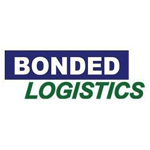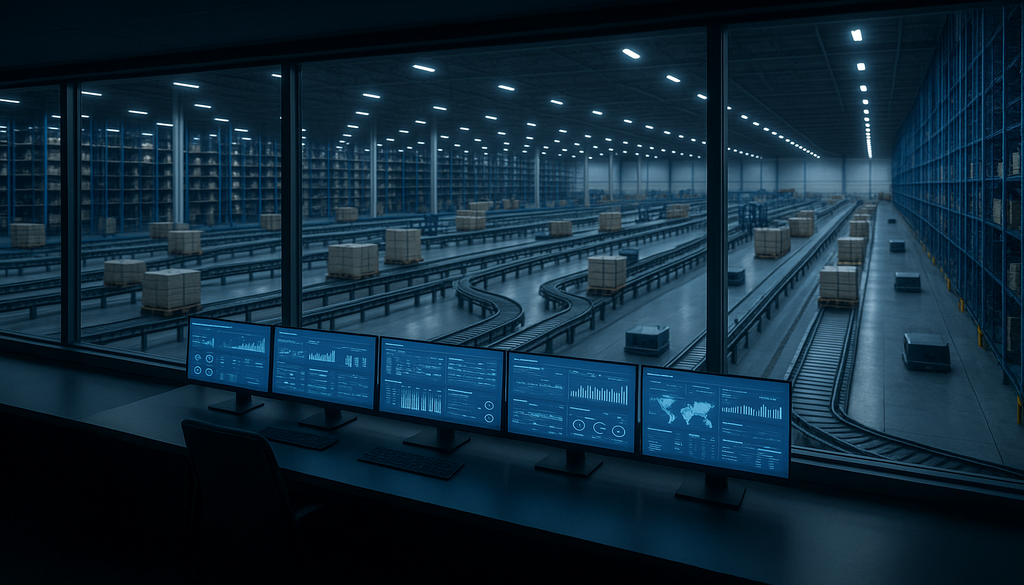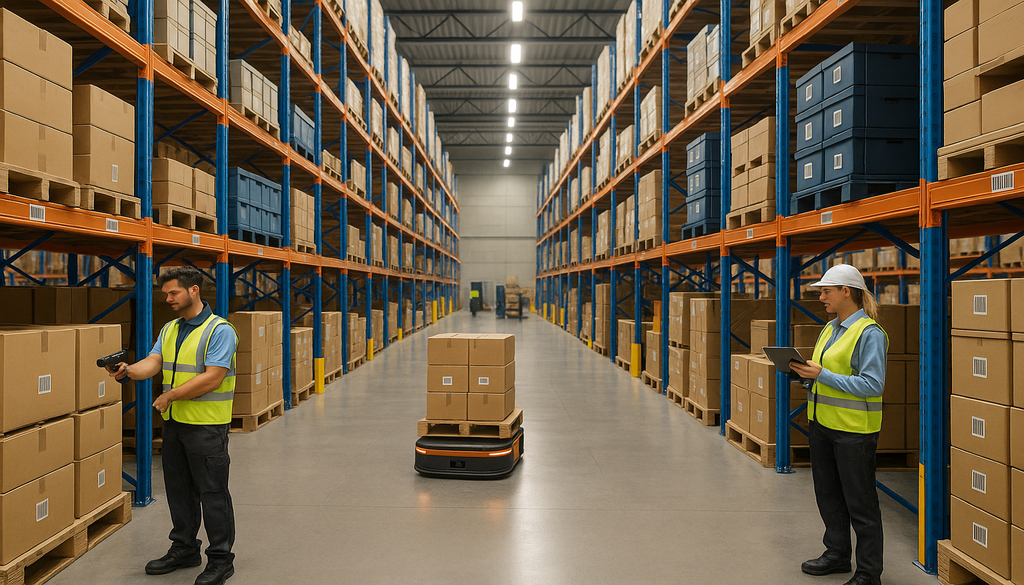Efficient WMS Integration: Streamlining Your Warehouse Operations
Considering a WMS integration for your warehouse? This article offers insights into simplifying your operations, slashing manual work, and elevating efficiency through a WMS. Expect a clear guide on integrating your warehouse management system effectively.
Key Takeaways
- An integrated WMS enhances operational efficiency by reducing manual data entry errors, improving inventory accuracy, and optimizing warehouse space utilization.
- WMS implementation requires strategic planning, choosing a suitable integration framework, and thorough testing to ensure compatibility and scalability for future growth.
- Advanced technologies like AI and ML are positioned to revolutionize WMS capabilities in the future. However, current technologies like barcoding, RF, and IoT are the best areas to focus on to optimize operations today.
The Advantages of WMS Integration
The benefits of integrating a warehouse management system (WMS) into your existing business systems are significant. The new integrated system not only streamlines operations but also enhances inventory management, and reduces reliance on manual data entry.
Achieving Operational Synergy
Consider the magic that happens when everything in a warehouse operates in harmony. Integrated systems can make this a reality by facilitating a seamless flow of information and streamlining operations. This not only minimizes the silo effect but also makes warehouse operations more effective by:
- Reducing process complexities.
- Improving inventory accuracy.
- Increasing productivity.
- Optimizing space utilization.
- Enhancing customer satisfaction.
A WMS is the central hub that coordinates all activities, effectively putting your warehouse operations on autopilot.
Reducing Manual Effort and Errors
One of the significant pain points in warehouse management is manual data entry. It’s not only time-consuming but also prone to errors. But imagine if you could automate this process. Integrating a warehouse management system with other business systems allows for this automation, reducing the need for manual data entry, and minimizing errors.
Enhancing Inventory Oversight
Inventory management can be a daunting task. However, the integration of advanced software and IoT technologies in WMS has revolutionized this space. These technologies enable:
- Real-time monitoring of inventory.
- Optimizing supply chain fulfillment and preventing stock issues.
- Minimizing storage expenses.
- Optimizing product categorization based on demand patterns and shelf life.
An added bonus is that IoT connectivity, through the integration of sensors and smart devices, offers an additional layer of control and visibility.

The Blueprint for Successful WMS Integration
Having covered the benefits, it’s time to explore the path toward successful WMS integration. It’s not just about choosing a vendor and implementing a solution. This process involves establishing clear, measurable objectives, communicating vital information with the WMS vendor, and performing extensive testing.
Strategic Planning and Analysis
Just as a well-built house requires a solid foundation, successful WMS integration begins with strategic planning and analysis. This requires setting clear integration goals, analyzing current workflows, and taking into account both software and hardware aspects of your warehouse operations.
Additionally, the WMS should be customizable, integrable, and scalable to handle increased data and transaction volumes, preparing for warehouse growth.
Selecting the Right Integration Framework
Choosing the appropriate integration framework is the succeeding step in the blueprint. This is pivotal as it enhances hardware and software integrations, leading to decreased errors, time savings, and consolidated critical information. When choosing a WMS integration framework, it is essential to assess providers based on operational fit, system flexibility, integration efficiency, scalability potential, and the level of ongoing support they offer.
Moreover, to support future growth, a modular system should be selected, which can be expanded with new functions and modules as needed, avoiding the necessity of a complete system overhaul.
Testing for Quality Assurance
After establishing the foundation and selecting the suitable framework, testing becomes the subsequent step. Testing the WMS in a real-world setting is crucial to spot and fix potential issues, ensuring the system’s readiness for actual operational demand. This might involve simulating warehouse processes in a controlled virtual environment and creating test data that accurately reflects real-world order scenarios.
A comprehensive approach to testing strengthens the assurance that the WMS can endure and perform during unexpected events.
At this point, let’s say that you’ve decided on a WMS and have begun the integration process. Great job. However, the journey continues. During the full system setup and post-integration, it’s crucial to continuously monitor and optimize system performance to ensure smooth operations.
Here’s how to proceed with this.
Implementing the Integration Solution
The initial setup of WMS integration requires a solid foundation within the warehouse, which involves identifying exact storage locations, setting up strategic workstation placements, and equipping the space with essential hardware. A well-communicated and clearly understood integration approach with the WMS vendor ensures a tailored integration approach. Focus on adjusting the system to fit your unique workflow and business processes to support your particular operational model.
Lastly, user onboarding to your cloud WMS includes designating user roles, defining their responsibilities within the system, and setting up customized permissions.
Monitoring and Fine-tuning
With the integration complete, what’s the next step? Now comes the part where you monitor and fine-tune the WMS performance based on feedback and changing business needs. This involves measuring key performance indicators (KPIs) to ensure continuous improvement and alignment with business needs.
It’s also about measuring the effectiveness of training by assessing its impact on warehouse efficiency and data accuracy, which can help improve future training initiatives.
Overcoming Technical and Human Challenges
As you navigate through the integration process, it’s important to be prepared for challenges. These can be technical, such as data quality and consistency, data security, and privacy. Or they can be human challenges such as change management for staff training. These challenges can be effectively managed by conducting risk assessments, assigning responsibilities, adopting a phased rollout strategy, and focusing on the configurability of the WMS.

Optimizing Logistics Operations with WMS-TMS Integration
WMS integration isn’t an isolated process but part of a broader ecosystem that often includes Transportation Management Systems (TMS). Integrating your WMS with a TMS not only strengthens your supply chain resilience but also streamlines logistics operations, creating a more cohesive and efficient workflow. This collaboration helps in several ways:
- Reducing Redundancy: Eliminates duplicate data entry across the systems, increasing data integrity and reducing potential errors.
- Boosting Efficiency: Enhances overall operational efficiency by optimizing the routing of outbound loads and streamlining the order consolidation process.
- Improving Adaptability: Allows businesses to swiftly adjust their logistics strategies in response to supply chain fluctuations, ensuring uninterrupted operations.
Mitigating Supply Chain Disruptions with Integrated WMS and TMS
Supply chain disruptions pose significant challenges, but the strategic integration of your WMS with a TMS provides a robust response mechanism. This integration enhances control over inventory flows and improves visibility into inbound and outbound shipments, which is crucial for:
- Enhanced Visibility: Offers improved insights into shipment statuses, helping to anticipate and manage delays or unexpected changes in supply chain dynamics.
- Rapid Response: Enables quicker adjustments to logistics processes in response to operational disruptions, such as labor shortages or sudden shifts in market demand.
Read more: Warehouse Management: WMS, TMS, LMS: Choosing Best-of-Class Solutions
Streamlining Warehouse and Enterprise Operations with WMS-ERP Integration
For many businesses, the integration of warehouse management systems with Enterprise Resource Planning (ERP) systems is crucial for achieving a seamless operational workflow. This integration ensures that information flows efficiently between the warehouse and the broader enterprise operations, enhancing data accuracy and facilitating better decision-making. Key benefits include:
- Data Consistency: Ensures consistent and accurate data across all enterprise and warehouse operations, which is vital for maintaining inventory accuracy and reducing errors.
- Operational Synergy: Creates a synchronized operation environment where inventory management is fully aligned with the broader business processes, leading to more informed strategic decisions and improved operational agility.
- Resource Optimization: Streamlines resource allocation by providing comprehensive insights into both warehousing and broader enterprise needs, improving the efficiency of resource use across the company.
Addressing ERP and WMS Integration Challenges for Smoother Operations
Integrating WMS with ERP systems presents unique challenges, particularly in aligning different system architectures and ensuring the seamless transfer of data. To overcome these challenges, it is essential to:
- Ensure Compatibility: Conduct thorough compatibility checks and employ middleware if necessary to facilitate smooth data exchange between the systems.
- Implement Gradual Rollouts: Adopt a phased approach to integration to minimize disruptions and allow for adjustments based on real-time feedback and system performance.
Future-Proofing Your WMS Integration
We have focused on the present until now. What about planning for the future? As businesses grow and technologies advance, your WMS integration needs to be future-proofed. This involves planning for scalability and staying current with technological advances.
Preparing for Business Expansion
As your business grows, so should your WMS. Scalability in an integration solution allows for additional systems and functionalities to be added without a complete overhaul, thus saving time and resources while minimizing disruptions.
Also, planning for the specific requirements of a warehouse’s expansion, such as budget and resource constraints, ensures the WMS can effectively scale with the business through enterprise resource planning.
Staying Current with Technological Advances
In this fast-paced digital world, staying current with technological advances is not a luxury but a necessity. This includes staying aware of advancing technologies like AI, machine learning, and IoT in WMS. Also, regularly reviewing and updating the WMS to adapt to both internal operational shifts and external technological advancements.
With the increasing adoption of cloud-based WMS solutions, thankfully, things like remote accessibility and scalability have already become easier than ever before.
Leveraging Advanced Technologies in WMS

Established Technologies in WMS
Warehouse management has been revolutionized by the implementation of established technologies such as RF and barcoding. These technologies provide substantial benefits by enhancing the accuracy and speed of inventory tracking:
- RF (Radio Frequency): Offers unparalleled visibility into inventory by allowing items to be tracked throughout the warehouse. This technology greatly reduces manual entry and minimizes entry errors.
- Barcoding: Continues to be a foundational technology for inventory management, enabling quick data capture and processing which improves overall operational efficiency.
- IoT (Internet of Things) for Real-Time Tracking: The integration of IoT devices in warehouse management supports real-time monitoring and immediate adjustments to inventory levels. IoT enhances the ability to track and manage inventory dynamically, leading to significant improvements in supply chain responsiveness.
Exploring AI and ML as Emerging Technologies in WMS
While technologies like RF and IoT are already making significant impacts, Artificial Intelligence (AI) and Machine Learning (ML) are positioned as the next horizon of technological advancement in warehouse operations. Although their current use in warehouse management is not widespread, their potential for future applications is significant:
- Predictive Analytics with AI and ML: These technologies are beginning to show promise in analyzing large datasets to predict inventory demand trends. By understanding historical sales and inventory data, AI and ML can help optimize stock levels and anticipate future needs.
- Automating Complex Decisions: AI and ML have the potential to automate complex decision-making processes in inventory management, reducing reliance on manual oversight and enhancing overall accuracy.
- Enhancing Forecasting Accuracy: As these technologies continue to mature, they will improve forecasting accuracy over time, learning from ongoing data to minimize errors and adapt to changing market conditions.
Ensuring Smooth Operation: Training and Support
Lastly, it’s time to address the human element of WMS integration: training and support. Comprehensive training and ongoing support are not just nice-to-haves. They’re essential for ensuring smooth WMS integration and operation.
Developing Comprehensive Training Programs
The success of any new system depends largely on how well its users can operate it. That’s where training comes in. A comprehensive WMS training program should cover:
- Basic navigation.
- Advanced system functionalities.
- Customizing training to different user roles.
- Identifying key users and defining the necessary capabilities they must have with the WMS.
To make the training more effective, real-world scenarios and examples should be incorporated, and modular training components should be used to allow employees to focus on specific WMS functionalities.
Building a Supportive Environment
Training is just the start. What follows is equally important – ongoing support and a supportive environment. This involves:
- Assembling a dedicated implementation team.
- Providing ongoing support and troubleshooting assistance after training.
- Encouraging a culture of continuous learning within the organization.
- Measuring the outcomes and benefits using Key Performance Indicators (KPIs) and metrics.
- Collecting feedback from staff and customers.
Regular training updates should be provided to keep employees informed about new WMS features and improvements.
Cadre Technologies: Your Partner in Advanced WMS Solutions
At Cadre Technologies, we pride ourselves on being at the forefront of warehouse management solutions, delivering systems that are not only robust but also tailored to meet the unique needs of modern businesses. Our state-of-the-art WMS solutions are designed to streamline operations, enhance efficiency, and boost productivity across your supply chain.
Innovative Technology: Leveraging the latest in RF and barcoding Cadre Technologies ensures real-time tracking and management of inventory, providing unprecedented visibility and control over your warehouse operations.
Scalable Solutions: Understanding that businesses grow and change, we provide scalable WMS solutions that grow with you. Our systems are designed to accommodate additional functionalities as needed, ensuring a seamless and cost-effective scalability.
Dedicated Support: At Cadre Technologies, we believe in not just selling a product but in forging partnerships. We offer comprehensive training and ongoing support to ensure smooth implementation and operation, helping our clients achieve and maintain operational excellence.
Choose Cadre Technologies to empower your warehouse operations with cutting-edge technology and unmatched support, positioning your business for success in the competitive marketplace.
Conclusion
Implementing an effective Warehouse Management System (WMS) is crucial for optimizing warehouse operations, enhancing inventory accuracy, and improving overall efficiency. With the right integration of technologies like RF, IoT, and barcoding, businesses can achieve real-time tracking, reduce errors, and streamline logistics operations.
As you look to future-proof your warehouse operations and keep pace with the evolving demands of the supply chain, consider the robust, scalable solutions offered by Cadre Technologies. Our systems are designed with your operational needs in mind, providing you with the tools you need to succeed.
Ready to elevate your warehouse operations? Contact Cadre Technologies today to learn how our WMS solutions can transform your business operations, or visit our website for more information. Let us help you take the first step towards a more efficient and integrated warehouse management system.
Frequently Asked Questions
What is WMS integration?
WMS integration involves linking a Warehouse Management System with other business software systems to enhance the flow of information within a warehouse. This integration reduces manual tasks and errors by allowing systems to share inventory information accurately and efficiently.
What are the four types of WMS?
Some professionals like to consider there to be four main types of Warehouse Management Systems:
- Standalone WMS: A standalone system primarily focuses on warehouse operations without integration into broader business systems.
- ERP Module-based WMS: This type of WMS is integrated as a module within an Enterprise Resource Planning system, facilitating a unified approach to business management.
- SCM Module-based WMS: Similar to ERP-integrated systems, this WMS is part of a broader Supply Chain Management suite, which helps manage end-to-end supply chain activities.
- Cloud-Based WMS: A system hosted on cloud services that offers scalability, remote accessibility, and often, subscription-based pricing.
What is the meaning of WMS?
A Warehouse Management System (WMS) is a software application designed to support and optimize warehouse functionality and distribution center management. It facilitates the management of inventory movements and storage in warehouses and assists in the processing of transactions, including shipping, receiving, stocking, and picking.
What is a WMS interface?
A WMS interface refers to the graphical user interface (GUI) of a Warehouse Management System, which allows users to interact effectively with the system. It typically provides tools for managing inventory, monitoring warehouse operations, and analyzing performance data.
What is an integration between ERP and WMS?
Integration between an Enterprise Resource Planning (ERP) system and a Warehouse Management System (WMS) involves connecting the two systems to allow for a seamless flow of information. This integration enables real-time communication and data exchange, which improves inventory management, enhances decision-making, and streamlines overall operations.













